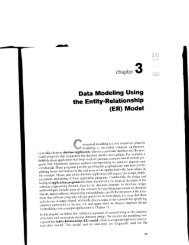13.1 through 13.5, 13.10 and 13.11
13.1 through 13.5, 13.10 and 13.11
13.1 through 13.5, 13.10 and 13.11
Create successful ePaper yourself
Turn your PDF publications into a flip-book with our unique Google optimized e-Paper software.
Chapter 13 Disk Storage, Basic File Structures, <strong>and</strong> Hashingically loaded onto tape drives-are becoming popular as tertiary storage to hoidterabytes of data. For example, NASA's EOS (Earth Observation Satellite) systenrstores archived databases in this fashion.Many large organizations are already finding it normal to have terabyte-sized databases.The term very large database can no longer be precisely defined because diskstorage capacities are on the rise ancl costs are declining. Very soon the term may bereserved for datirbases containing tens of terabytes.<strong>13.1</strong>.2 Storage of DatabasesDatabases typically store large amounts of data that must persist over long periodsof time. The data is accessecl <strong>and</strong> processed repeatedlyduringthis period. This contrastswith the notion of transient data structures that persist fbr only a limited timeduring program execution. Most databases are stored permanently (or persistentlyton magnetic disk secondary storage, for the following reasolts:w Generally, databases are too large to fit entirely in main memory.* The circumstances that cause permanent loss of stored data arise less frequentiyfor disk secondary storagc than for primary storage. Hence, we referto disk-<strong>and</strong> other secondary storage devices-as nonvolatile storage,whereas mirin memory is ofien callecl volatile storage.* The cost of storage per unit of data is an order of magnitude less for disk secondarystorage than for primary storage.Some of the newer technologies-such as optical disks, DVDs, <strong>and</strong> tape jukeboxes-arelikely to provide viable alternatives to the use of magnetic disks. In thefuture, databases may therefore reside at different levels of the memory hierarchrfrom those described in Section l3.l.l. However, it is anticipated that magneticdisks will continue to be the primary medium of choice for large databases for yearsto come. Hence, it is important to study <strong>and</strong> underst<strong>and</strong> the properties <strong>and</strong> characteristicsof magnetic disks <strong>and</strong> the way dirtar files cirn be organized on disk in order todesign effective databases with acceptable performance.Magnetic tilpes are frequer-rtly used as a storage medium for backing up databasesbecause storage on tape costs even less than storage on disk. However, access to dataon tape is quite slow. Data stored on tapes is offline; that is, some intervention by anoperator-or an etutomatic loading device-to load a tape is needed before the databecomes available. In contrast, disks are online devices that can be accessed clirectlrat any time.The techniques used to store large amounts of structured data on disk are importantfor database designers, the DBA, <strong>and</strong> implementers of a DBMS. Databas.-designers <strong>and</strong> the DBA must know the advantages <strong>and</strong> disadvantages of each storagetechnique when they desigr-r, implement, <strong>and</strong> operate a database on a specificDBMS. Usually, the DBMS has several options available for organizing the data. Theprocess ofphysical database design involves choosing the particular data organizationtechniques that best suit the given application requirements from among thc














